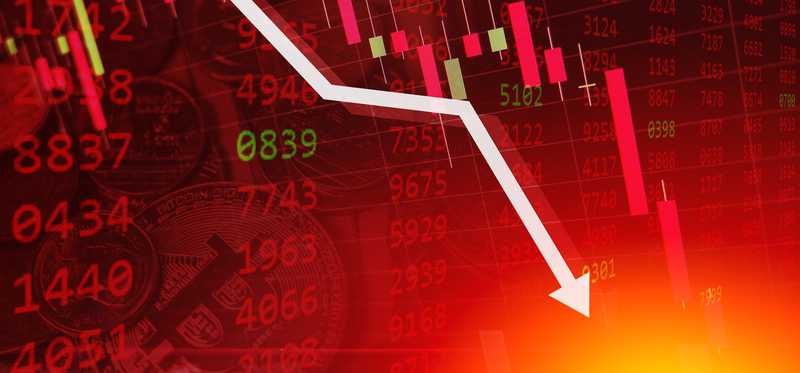15 Key Investing Strategies to Navigate the Next Bear Market

15 Key Investing Strategies to Navigate the Next Bear Market
Another bear market is unavoidable, so don't get caught off guard
The market has had its fair share of dramatic swings lately, and the volatility may be far from over. If another bear market appears in the near future, you don't want to be caught unprepared.
Let's take a look at 15 investing strategies you need to know to navigate the next bear market and come out on the other side.
5 Stocks Under $49
Presented by Motley Fool Stock Advisor
We hear it over and over from investors, "I wish I had bought Amazon or Netflix when they were first recommended by The Motley Fool. I'd be sitting on a gold mine!" It's true, but we think these 5 other stocks are screaming buys. And you can buy them now for less than $49 a share! Click here to learn how you can grab a copy of "5 Growth Stocks Under $49" for FREE for a limited time only.
Previous
Next

1. Consider bear market events within the context of your overall investing outlook
Bear markets are a scary event for most investors, and that's completely understandable. However, a bear market doesn't need to stop you in your tracks or rattle your investing strategy. When you're investing in the stock market for decades, even if it takes the market a few years to totally recover, that's still a relatively minute slice of your overall investing outlook.
Will all the stocks you own recover from the next bear market? Potentially not. However, if you continue to invest in truly great companies with solid leadership, favorable balance sheets, and businesses that can drive future and lasting growth, you can keep building a balanced portfolio that delivers profits and growth over many years.
ALSO READ: What Is a Bear Market and How Should You Invest in One?
Previous
Next

2. Don't make major changes to your portfolio in the heat of the moment
One of the most common urges investors face during a bear market period is the impulse to sell off their stocks when the market turns red. This can be a truly grave mistake.
Cashing out your portfolio in the heat of the moment may not only make your losses greater but permanently wipe out your positions in otherwise great companies that you're only selling because the price has changed, not because the underlying business has.
Previous
Next

3. Never, ever invest cash that you'll soon need
One reason investors needn't fear a bear market is the simple fact that these periods can provide plenty of sound buying opportunities to grab great stocks that are trading on sale.
Of course, there are certain situations when it may be best to leave your portfolio alone during a bear market. For example, you should not be investing your emergency fund or cash that you might otherwise need in the next few years.
When the next bear market rolls around, be sure to only invest cash that you are perfectly fine putting into stocks and leaving alone for the next several years at least.
ALSO READ: 3 Things the World's Smartest Investors Do in Every Bear Market
Previous
Next

4. Don't jump in and out of the market
Investing in the stock market isn't going to make most investors get rich overnight. While the idea of implementing a life-changing trade based on a stroke of luck in the market isn't a realistic goal, it also isn't one you need to have.
As an investor, continuing to build your portfolio just as consistently when the market is in bear territory as when a bull market is in full swing is how you can build prolonged returns that accumulate wealth over years.
On the other hand, jumping in and out of the market in the midst of a downturn in hopes of encountering the best moments to buy or sell could very well end in disaster for your portfolio, because your chances of getting those moments right are next to zero.
Previous
Next

5. Don't fear a bear market -- use it to your benefit
If you're in the right mindset, a bear market doesn't need to scare you as an investor. If you are in a position to invest during the next bear market, you can use that window to invest in companies with durable competitive advantages and growth tailwinds.
Not only will your capital go further in this type of market environment but you'll be in a prime position to enjoy the market's recovery when it does happen.
5 Stocks Under $49
Presented by Motley Fool Stock Advisor
We hear it over and over from investors, "I wish I had bought Amazon or Netflix when they were first recommended by The Motley Fool. I'd be sitting on a gold mine!" It's true, but we think these 5 other stocks are screaming buys. And you can buy them now for less than $49 a share! Click here to learn how you can grab a copy of "5 Growth Stocks Under $49" for FREE for a limited time only.
Previous
Next

6. Keep some cash outside your portfolio
Remember how we talked about not investing cash you're going to need soon? You also want to make sure that you are not putting all of your cash into your portfolio.
If an emergency or some other life event occurs, you don't want to have to draw from your portfolio to access that money, particularly during a bear market when share prices across a wide range of industries tend to be heavily depressed.
ALSO READ: The Only Stock Warren Buffett Has Bought in Each of the Last 2 Bear Markets
Previous
Next

7. Focus on resilient investments that can generate profits and growth over the long term
When you're investing during a bear market, it can be tempting to put your cash into companies simply because they are outperforming the market at that point in time. But just because the stock is trading up or down during a bear market doesn't make it a good or a bad investment off the bat.
Do your research before you buy shares of any company. Make sure it's the right fit for your portfolio over the long term prior to investing your hard-earned cash.
Previous
Next

8. Systematically invest a set amount of money into the stocks you love
You may have heard of the strategy of dollar-cost averaging, which essentially involves regularly investing a specific dollar amount in stocks or other assets. This simple strategy is effective in any environment, and it can be an especially valuable tool to help you make the best use of your capital when the market is trading down.
When you treat investing more like a habit, instead of a means of trying to predict the most effective or ineffective windows to infuse your capital into the market, you'll not only gain the advantage of buying stocks on sale during down periods but also be ready to enjoy the profits and returns of the up markets.
Previous
Next

9. Invest in stocks and sectors with a certain level of noncyclicality
The kinds of stocks and industries you're drawn to will depend on a great many factors that are generally personal to you. However, it's always a good idea to balance your portfolio with investments that are more recession resistant and noncyclical.
For example, companies that sell products that people use on a daily basis tend to lend a certain level of noncyclicality to your portfolio, because even when consumers are strapped for cash, these businesses are still a go-to for the items they need and use regularly.
Previous
Next

10. Limit your portfolio check-ins
It's certainly natural to want to check how your portfolio is doing, and it's important to make a habit of evaluating your holdings and the balance of your basket of investments from time to time.
That being said, checking your portfolio too often, especially during a market downturn, could induce you to make some questionable judgments about your portfolio and simply isn't going to be helpful.
If you find yourself checking your portfolio every day (or even multiple times a day), it's probably best to reel that in and limit your portfolio check-ins to once a week. You don't need to get overly caught up in intraday movements in your portfolio that are likely to fluctuate immensely in a bear market environment.
5 Stocks Under $49
Presented by Motley Fool Stock Advisor
We hear it over and over from investors, "I wish I had bought Amazon or Netflix when they were first recommended by The Motley Fool. I'd be sitting on a gold mine!" It's true, but we think these 5 other stocks are screaming buys. And you can buy them now for less than $49 a share! Click here to learn how you can grab a copy of "5 Growth Stocks Under $49" for FREE for a limited time only.
Previous
Next

11. Don't overconcentrate your asset allocation
The dangers of overconcentrating your cash into only a few stocks or sectors are definitely not limited to a bear market. However, the downside of failing to diversify can become even more apparent in these types of markets.
When your capital is evenly spread across numerous stocks and sectors, it not only gives your portfolio more opportunities to experience returns but can even lessen your portfolio's reaction to a bear market because you're not overly exposed to a particular company or industry.
ALSO READ: Better Bear Market Buy: Coca-Cola vs. Procter & Gamble
Previous
Next

12. Don't follow the hype
In a day and age where hyped-up retail-trading frenzies are common, it can be easy to get caught up in the latest and greatest investing scheme without looking to see whether there's a durable underlying asset behind it.
These types of "investment opportunities" can rise to the forefront when the market has entered bear territory, simply because investors are looking for any and all ways to stop their portfolio from hemorrhaging.
An investment may be popular for a good reason, but it's important to be just as judicious about using your capital and researching an investment during a bear market as you would during a bull market.
Previous
Next

13. Don't tap into your emergency fund
Your emergency fund should always be a stand-alone entity from your investment portfolio. This is not money that you should invest, and you shouldn't ever lump in your emergency fund with your basket of investments.
While stocks are a relatively liquid asset, emergencies rarely occur at opportune times. If one does happen and your emergency fund is tied up with your investments, you could be forced to sell stocks at a bad time in the market simply because you don't have enough cash outside your portfolio.
ALSO READ: Tech Sell-Off: 1 Nasdaq Stock Down 61% to Buy Before It Starts Soaring
Previous
Next

14. Don't sell your stocks in an effort to reduce your bear market losses
Violent swings in your portfolio are tough to bear. Nonetheless, it's common to see plenty of them when the market is experiencing a downturn.
If your stocks are trending down with the broader market, don't rush to sell them unless you have a robust thesis for doing so that goes beyond changes in the price of the asset.
Previous
Next

15. Don't let market noise induce you to buy or sell stocks
Sometimes a stock is down for a very good reason, such as changed messaging from management that is driving investors away or concerning developments with the business itself. However, if you find yourself contemplating a stock dump only because shares are trading down, you may not only end up selling a quality investment but also turning volatile share action into a perpetual loss in the process.
Likewise, if you find yourself drawn to a stock simply because shares are trading up in an otherwise depressed market, don't invest on that reason alone.
In any market, bull or bear, your choice to buy or sell a stock should be founded upon a solid strategy and thesis that takes into account the business itself, its core financials, your personal ability to handle risk in your portfolio, and the overarching investment goals you have set for yourself.
5 Stocks Under $49
Presented by Motley Fool Stock Advisor
We hear it over and over from investors, "I wish I had bought Amazon or Netflix when they were first recommended by The Motley Fool. I'd be sitting on a gold mine!" It's true, but we think these 5 other stocks are screaming buys. And you can buy them now for less than $49 a share! Click here to learn how you can grab a copy of "5 Growth Stocks Under $49" for FREE for a limited time only.
Previous
Next

A turbulent market may feel scary, but it can be a golden opportunity for long-term investors
If you've ridden out previous bear markets, you may or may not be experiencing much trepidation about the prospect of another one. Even so, the unique combination of events that have been driving market actions lately has unnerved investors of all ages and experience levels.
It's a perfectly natural, human reaction. However, your investment strategy or approach to the stock market shouldn't be predicated on what it's doing over the next few weeks, months, or even years.
If you're in a position to invest in the next bear market, you may find a golden opportunity to buy wonderful companies at far lower prices than you usually would.
At the same time, if you don't feel comfortable putting capital to work in a bear market, staying hands-off your portfolio for a time can be just as ingenious a strategy to maximize your returns over the long run and avoid making potentially costly mistakes based on panic or greed.
The Motley Fool has a disclosure policy.
Previous
Next
Invest Smarter with The Motley Fool
Join Over Half a Million Premium Members Receiving…
- New Stock Picks Each Month
- Detailed Analysis of Companies
- Model Portfolios
- Live Streaming During Market Hours
- And Much More
READ MORE
HOW THE MOTLEY FOOL CAN HELP YOU
-
Premium Investing Guidance
Market beating stocks from our award-winning service
-
The Daily Upside Newsletter
Investment news and high-quality insights delivered straight to your inbox
-
Get Started Investing
You can do it. Successful investing in just a few steps
-
Win at Retirement
Secrets and strategies for the post-work life you want.
-
Find a Broker
Find the right brokerage account for you.
-
Listen to our Podcasts
Hear our experts take on stocks, the market, and how to invest.
Premium Investing Services
Invest better with The Motley Fool. Get stock recommendations, portfolio guidance, and more from The Motley Fool's premium services.